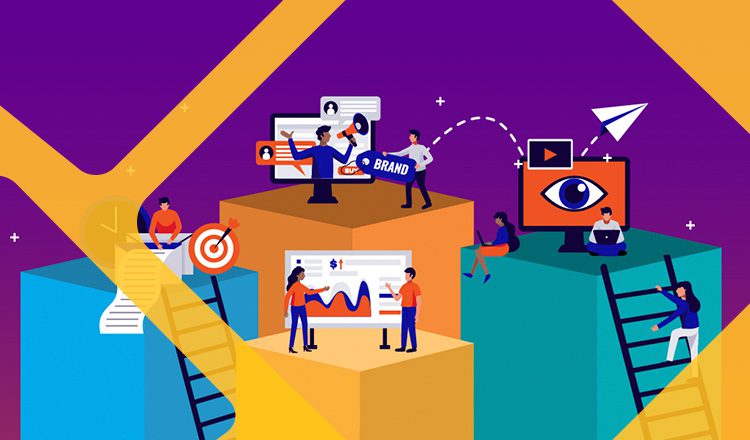This post has been contributed by Patrick Foster.
More and more B2B organizations have started to embrace customer-centricity as a core part of their ethos, and to great advantage. However, a core consideration that often gets neglected is recognizing and adapting to customer behavior – much to our detriment, as it can result in many a lost sale. The solution: understand and act on your customer decision journey.
The B2B customer journey is often fragmented and spread across multiple channels. Unlike B2C, it involves a range of stakeholders and decision makers, and is supported by the strength of the overall brand and its content. As purchase processes evolve, it’s time to do away with the linear sales funnel and recognize that the purchase path is changing – and will continue to do so.
What are the steps of the B2B customer journey?
Having a clear understanding of the B2B customer journey map from start to finish is one of the most crucial aspects of developing any successful marketing campaign. There are several key phases that must be identified and acted upon, and while they may slightly differ between companies, largely they tend to follow a similar pattern.
The phases can be categorized as follows:
- Awareness – a need is identified
- Consideration – the buyer conducts their research
- Assessment – the best options are compared
- Preference – a vendor is approved and selected
- Purchase – implementation goes ahead
- Evaluation – the results of that implementation are reviewed
Or to put it even more simply, it goes: awareness > consideration > decision. Helpful visualizations of the B2B customer journey can be found here.
B2B marketers must focus their efforts on marketing that targets buyers at every stage of the customer journey. In the first stage (awareness) it’s all about being on the map. Good branding and online visibility (usually achieved with PR, SEO and media ads) are imperative to ensure that potential customers think of you as they begin their search.
In the second stage (consideration) it’s all about showing how knowledgeable you are and providing useful content; in other words, your content marketing strategy. This is how you position yourself as an industry leader. Testimonials and reviews from previous clients will factor in here too.
And finally, when the buyer comes to make their decision in the third stage, it’s about cultivating those personal relationships and offering outstanding customer service that will help the customer to see the value of working with your organization in the long-term.
How is it different to the B2C customer journey?
Some marketers make the mistake of thinking that marketing is marketing and there doesn’t need to be a big distinction between how you approach B2B compared to B2C. However, the differences are fairly important. It’s logic-driven sales vs. emotion-driven sales. A strategy that works for one group won’t necessarily work for the other. Let’s review the key differences:
B2B sales are relationship-driven, aimed at a niche target market with a longer buying cycle. The buying decision is a rational one involving more than one decision-maker.
B2C sales are product-driven, aimed at a larger target market vulnerable to impulse purchases, emotional decision-making and other external influences.
The key difference here is the buyer’s perspective. A rational purchase decision is not the same as an emotional one, and requires a different approach to render any marketing efforts effective.
Our tips for B2B business owners
Really know your audience
You should constantly be drip-feeding new audience knowledge into the B2B customer journey. For example, does the demographic in question mainly use mobile or desktop? What times of the day are they active? When is best to email, phone, or message them? Will they want to download a whitepaper or PDF and read through that, or is a mailshot or a phone call better? Every organization will require a tailored approach.
Know where your prospective customers are looking
Do you know where your prospective buyers are looking for information? There are many channels to consider, both online and offline. Traditional marketing still has its place, in the form of events, consultants, salespeople, and so on. As the world becomes more digital, we should never underestimate the value of face-to-face networking. But of course, you need both. 71% of B2B researchers start their research with a generic search – doing 12 searches on average prior to engaging on a specific brand’s site (Source).
Mix up your online content with a decent quality blog, video case studies, webinars and a strong social presence to make yourself seen and heard. Don’t be afraid to jump on platforms like Twitter, LinkedIn, Medium, Quora and specialist industry sites to get a feel for what’s out there and what customers are seeking.
Provide ample informative content
Make no mistake, B2B decision makers spend a lot of time on their research. And as they do so, they’ll start to drill down into what it really is that they want. At this point in the process, they’ll have a lot of particular questions, and they’ll start to narrow their focus to just two or three vendors. To get to this stage (and beyond), having plenty of educational content (industry reports, white papers, etc.) is what will help you stand out.
Form a good relationship between sales and marketing
B2B sales and marketing are very closely allied. Understanding the customer decision journey can help to highlight any weaknesses in communication between your marketing and your sales team. Both need a firm understanding of this process, and both need to fully comprehend their role in that process, lest the overlap lead to mixed messages for your clients.
Don’t underestimate the benefits of inbound marketing and ‘smarketing’ for B2B niches, which are primarily information-heavy. Implementing a joint workflow with a CRM, project management tools like Basecamp, and team meetings can help to ensure that leads are being shared and that the right tone is adopted when leads are sent onto sales.
Be in tune with their organization
One of the most important things to strive for when working with B2B businesses is being in tune with the organization and their internal goals, deadlines, and values. In this instance, it’s all about the little things, for example, remembering that a client is submitting an application to an awards show and asking them how it went, or knowing when to hold off chasing a proposal because it’s tax return season.
Remember, people are sometimes quiet for a reason – it doesn’t mean you need to start getting more intense. Aggressive chasing can make you sound ‘shrill’ and out of step: not an appealing prospect for your customers.
Don’t neglect your business website
Why does a website matter for the customer journey? It doesn’t matter who you are or what you’re selling – if your website isn’t up to scratch then it could really be letting you down. A solid web design will maximize conversions and work for you 24/7.
There needs to be a lot of content on your website to educate customers, but contact details and signup forms also need to be easy and readily available. You want your website to be part of your sales team, so don’t put up with an old brochure style. A content library that includes videos can be used to persuade warm leads or educate new customers on how to use your products. Try to build a long-term digital relationship around your website.
Design trends are often changing, so if it’s been several years since your last upgrade, consider a refresh. Schedule regular reviews and publish relevant content to keep your business website fresh and impressive, and to help it show up in search rankings.
As well as optimizing your website for SEO, which is crucial to being found in the first place, you should also optimize for your users – that is, ensure the website is both easy to use and easy on the eye. Whether you choose to go with an online store builder or a more custom solution, you can’t go wrong with a clean, simple design. Think quality imagery, intuitive navigation, and minimal clutter.
Don’t forget to recognize your own goals
Don’t spend so much time focused on the customer that you forget about your own journey. Remember your organization’s goals, and keep track of them. Look beyond your transactions to see customer experience strategy as a bigger picture – after all, B2B relationships can last for years once a vendor has settled on you. It’s all about nurturing that relationship once it’s established, much like any other relationship that you want to succeed.
Bottomline
Building an organization around your customer decision journey is one of the best investments you can make, leading to more effective marketing strategies and higher sales. Take the next step from being a ‘customer-centric’ company and build an organization that wins business time and gain.
About the Author: Patrick Foster: eCommerce marketer. Patrick is an ecommerce marketer with 10+ years in the industry, working in both B2B and B2C eCommerce. He is currently writing as a side project. Patrick loves to create content for businesses and help them grow, no matter what stage they’re at.



